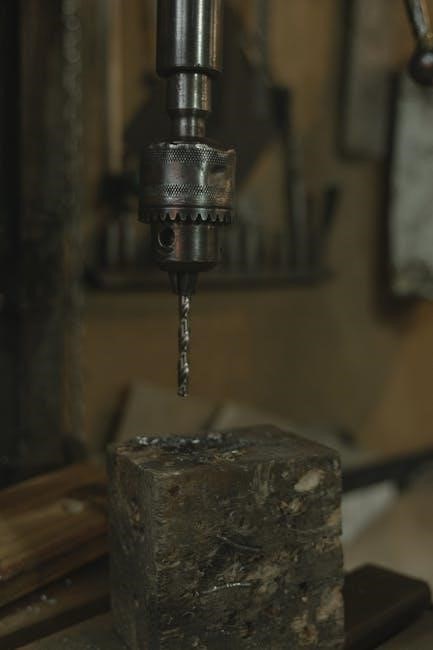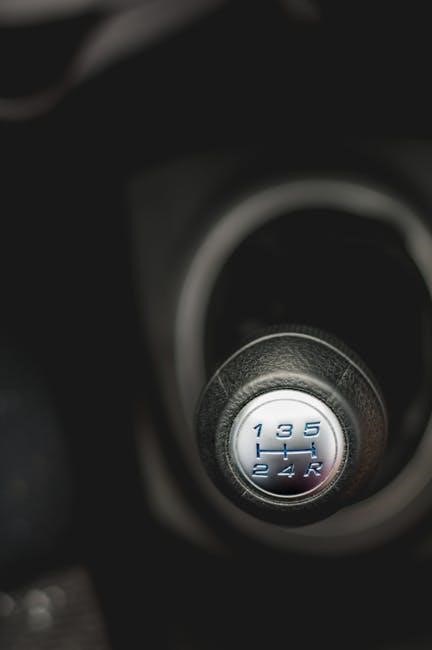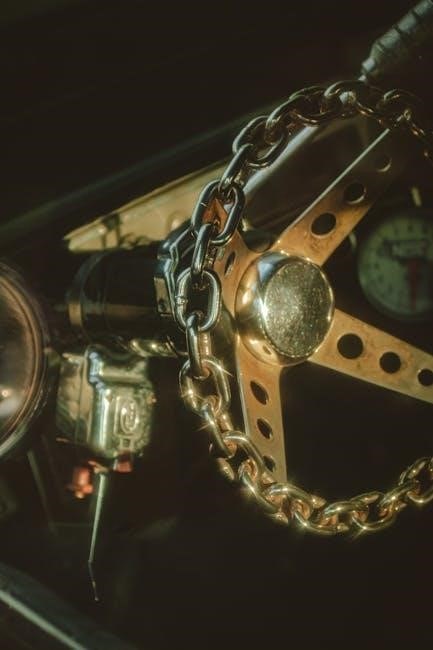Manual car stalls occur unexpectedly while driving‚ causing engine shutdown‚ and are a common issue for drivers‚ especially beginners‚ using manual transmission vehicles with clutch mechanisms and gear shifts normally.
Definition of a Stall
A stall refers to the sudden shutdown of a car’s engine‚ which can occur when the engine is not receiving enough power or when the clutch is not being used properly. This can happen when the car is in gear and the driver is not giving it enough gas‚ or when the driver is trying to start the car from a standstill. A stall can be frustrating and embarrassing‚ especially for new drivers who are still learning how to use a manual transmission. It is a common issue that can be caused by a variety of factors‚ including driver error‚ mechanical problems‚ or a combination of both. Understanding what a stall is and how it occurs is the first step in learning how to prevent it and recover from it. Effective prevention and recovery techniques require a good understanding of the car’s mechanics and the driver’s role in operating the vehicle safely.

Causes of Manual Car Stalls
Manual car stalls are caused by various factors including driver error normally.
Common Causes of Stalling
There are several common causes of stalling in manual cars‚ including improper use of the clutch pedal and gear shifting.
Driver error is a major contributor to stalling‚ particularly among inexperienced drivers.
Other common causes include starting on a hill‚ selecting the wrong gear‚ and not using enough acceleration when moving off.
Additionally‚ stalling can occur when the driver is not familiar with the car’s clutch mechanism and gear shifting patterns.
By understanding these common causes‚ drivers can take steps to minimize the occurrence of stalling and improve their overall driving skills.
Recognizing the common causes of stalling is essential to preventing it and ensuring a smooth driving experience.
Furthermore‚ being aware of these causes can help drivers to develop good driving habits and avoid stalling in different driving situations.
Role of the Clutch Mechanism
The clutch mechanism plays a crucial role in the operation of a manual transmission car‚ as it connects and disconnects the engine from the transmission.
The clutch pedal is used to engage and disengage the clutch‚ allowing the driver to shift gears smoothly.
A properly functioning clutch mechanism is essential to prevent stalling‚ as it enables the driver to control the flow of power from the engine to the transmission.
The clutch mechanism consists of several components‚ including the clutch plate‚ pressure plate‚ and release bearing‚ which work together to facilitate smooth gear shifts.
Understanding the role of the clutch mechanism is important for drivers to appreciate the importance of proper clutch use and maintenance to prevent stalling and ensure a smooth driving experience.
Effective use of the clutch mechanism requires a combination of proper technique and maintenance to prevent wear and tear on the components.

Prevention of Manual Car Stalls
Preventing manual car stalls requires proper driving techniques and maintenance habits regularly always.
Good Manual Transmission Practices
To minimize the occurrence of manual car stalls‚ it is essential to develop good manual transmission practices. This includes using the clutch pedal correctly‚ shifting gears smoothly‚ and avoiding riding the clutch. By doing so‚ drivers can reduce the wear and tear on their vehicle’s transmission and engine‚ which can help prevent stalls. Additionally‚ good manual transmission practices can also improve fuel efficiency and overall vehicle performance. Drivers should also be aware of their surroundings and adjust their driving accordingly‚ such as slowing down or speeding up to match the flow of traffic. By following these practices‚ drivers can become more confident and proficient in operating their manual transmission vehicle‚ reducing the likelihood of stalls and other issues. Regular maintenance and checks on the vehicle’s transmission and engine can also help identify potential problems before they cause a stall.
Recognizing Common Causes
Recognizing the common causes of manual car stalls is crucial in preventing them from happening. One of the primary causes is the incorrect use of the clutch pedal‚ such as releasing it too quickly or not pressing it down far enough. Another common cause is shifting into the wrong gear‚ which can put unnecessary strain on the engine and transmission. Drivers should also be aware of their surroundings‚ such as inclines or declines‚ and adjust their gear shifting accordingly. Furthermore‚ driving in heavy traffic or in areas with frequent stops and starts can also increase the likelihood of stalling. By being aware of these common causes‚ drivers can take steps to prevent stalls and become more confident and proficient in operating their manual transmission vehicle. Regular practice and experience can also help drivers develop the skills needed to recognize and avoid common causes of stalling.

Troubleshooting Manual Car Stalls
Troubleshooting manual car stalls involves identifying root causes and fixing issues with clutch mechanisms and gear shifts normally found in manual transmission vehicles every day.
Understanding the Clutch Mechanism
The clutch mechanism plays a crucial role in manual transmission vehicles‚ enabling drivers to shift gears smoothly and efficiently. Effective troubleshooting of manual car stalls requires a thorough understanding of the clutch mechanism and its components‚ including the clutch pedal‚ clutch disc‚ and pressure plate. By recognizing how the clutch mechanism operates‚ drivers can identify potential issues that may lead to stalling‚ such as worn or damaged clutch components‚ improper clutch pedal adjustment‚ or insufficient clutch maintenance. A comprehensive understanding of the clutch mechanism is essential for diagnosing and resolving manual car stall problems‚ allowing drivers to take corrective action and prevent future stalls from occurring. This knowledge enables drivers to operate their vehicles with confidence and precision‚ minimizing the risk of stalling and ensuring a safe and enjoyable driving experience. Regular clutch maintenance is also necessary.
Identifying the Root Cause
To effectively troubleshoot manual car stalls‚ it is essential to identify the root cause of the problem. This involves analyzing the circumstances surrounding the stall‚ including the driver’s actions‚ road conditions‚ and vehicle maintenance history. By examining these factors‚ drivers can determine whether the stall was caused by driver error‚ a mechanical issue‚ or a combination of both. Identifying the root cause enables drivers to take targeted corrective action‚ such as adjusting their driving technique or addressing underlying mechanical problems; A thorough understanding of the vehicle’s systems and components is necessary to accurately diagnose the cause of the stall. By taking a systematic approach to troubleshooting‚ drivers can resolve the issue and prevent future stalls from occurring‚ ensuring a safe and reliable driving experience. Regular vehicle maintenance and inspection can also help identify potential issues before they cause a stall.

Recovery from a Manual Car Stall
Drivers can recover from a stall by restarting the engine and shifting into gear‚ using clutch and accelerator pedals carefully and smoothly always.
What to Do If a Stall Happens
To recover from a stall‚ remain calm and follow proper procedures. First‚ ensure the vehicle is in a safe location‚ away from traffic. Next‚ shift the transmission into neutral and restart the engine. Once the engine is running‚ shift into first gear and slowly release the clutch pedal while pressing the accelerator. This will help the vehicle start moving again. It is essential to use the clutch and accelerator pedals smoothly to avoid another stall. If the vehicle stalls repeatedly‚ it may be necessary to check the clutch and transmission for any issues. By following these steps‚ drivers can quickly and safely recover from a stall and get back on the road. Regular practice and experience with manual transmissions can also help reduce the likelihood of stalling. Proper driving techniques are crucial to avoiding stalls.
Minimizing the Occurrence of Stalls
Minimizing stalls requires a combination of proper driving techniques and vehicle maintenance. Regular clutch and transmission checks can help identify potential issues before they cause a stall. Drivers should also be aware of their surroundings and adjust their driving accordingly‚ such as using a lower gear when stopping on an incline. Smooth and gradual acceleration‚ as well as avoiding sudden stops‚ can also help reduce the likelihood of stalling. Additionally‚ drivers should be mindful of their clutch and accelerator pedal usage‚ using a gentle and controlled touch to shift gears and accelerate. By following these tips and practicing good driving habits‚ drivers can minimize the occurrence of stalls and become more confident and competent behind the wheel. Proper vehicle maintenance and driving techniques can go a long way in reducing the frequency of stalls and ensuring a smooth driving experience.

No Responses